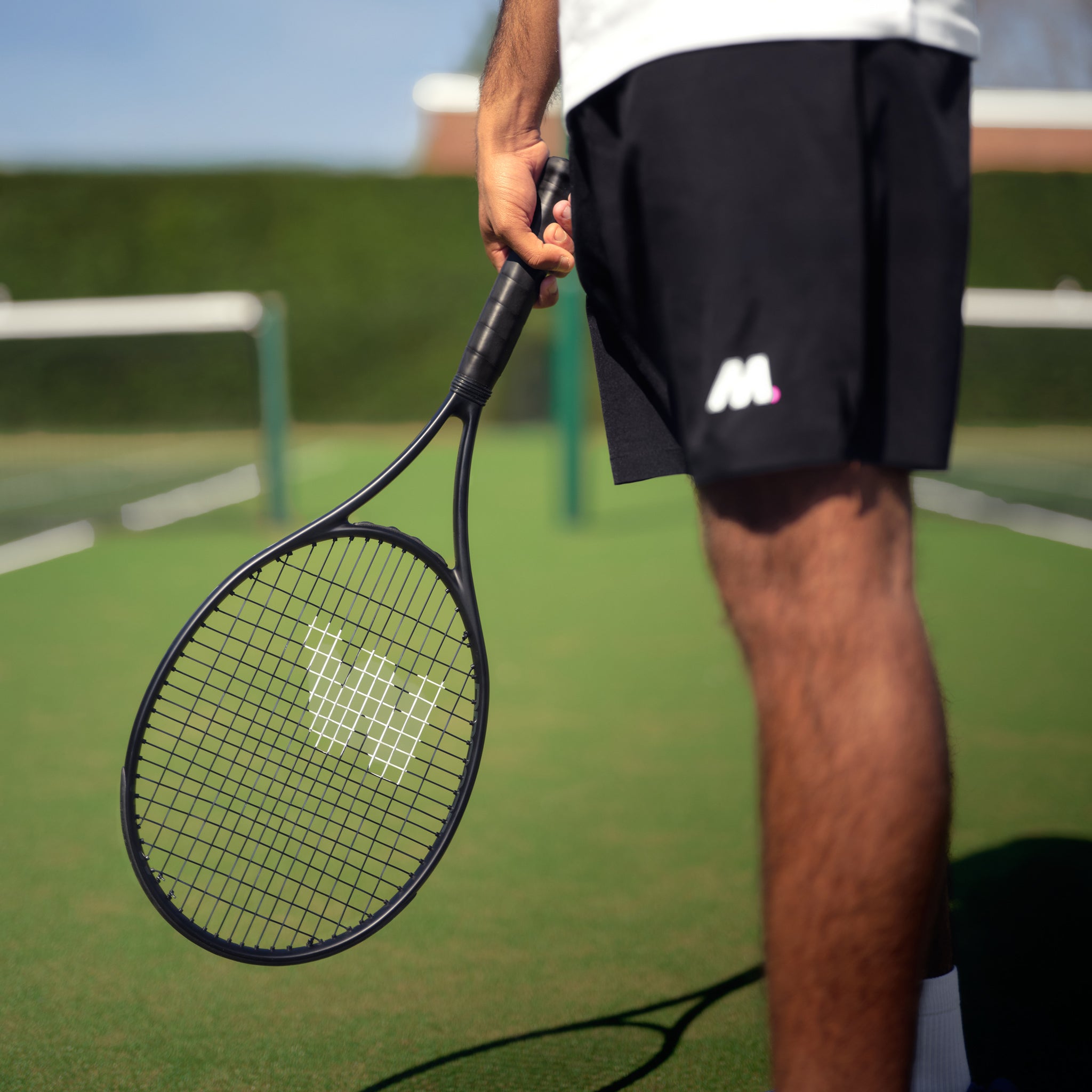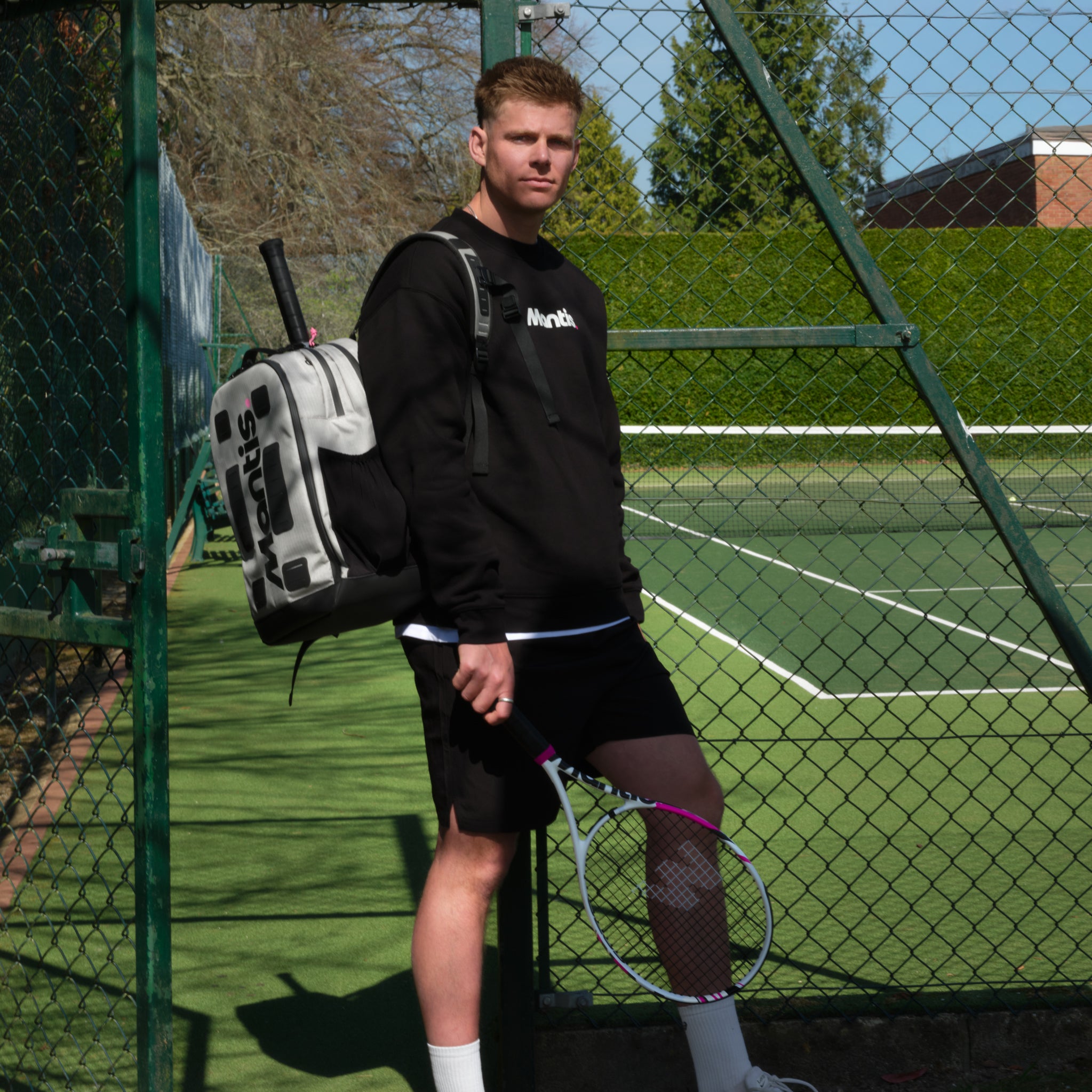
Online tennis instruction is a fantastic way to sharpen your game, blending video analysis, expert coaching, and drills you can do on your own time. At Mantis, we believe it's a powerful addition to your on-court practice, letting you fine-tune your technique whenever and wherever it suits you, and our guide on improving your tennis skills at home is a great place to start.
Why Online Tennis Instruction Is Changing the Game
The world of tennis coaching is no longer just about what happens on the court. At Mantis, we've seen how what started as a niche idea has quickly become a mainstream training tool for everyone from total beginners to serious competitors.
At Mantis, we’ve seen first-hand how tennis instruction online is reshaping the way players develop their skills. Our own article on improving your tennis skills at home is a great place to get started.
At first, a lot of players were sceptical. How could you possibly learn a physical sport through a screen? Could virtual feedback ever replace the immediate guidance of a coach standing right there with you? Well, modern technology has answered that question with a resounding "yes," bridging the gap between digital advice and real-world performance.
The Technological Leap Forward
High-definition video now allows for crystal-clear analysis of every single movement, from the way you grip your racket to the subtle rotation of your hips. This is often paired with slow-motion playback and annotation tools, letting coaches pinpoint the exact areas for improvement with a level of detail that’s easy to miss in a live session.
On top of that, the rise of AI-powered swing analysis gives you instant, data-driven feedback on your technique, tracking things like racket speed and swing path. Suddenly, a simple practice session becomes a goldmine of useful data. This has created a brilliant hybrid model where players can back up their on-court hitting with focused, analytical work at home.
The real game-changer here is accessibility. World-class coaching is no longer limited by your postcode. A player in a small town can now get personalised instruction from an expert on the other side of the world, levelling the playing field like never before.
This shift is mirrored in the sport's booming popularity. Since 2019, the demand for tennis lessons across the UK has shot up, with a 40% national increase reported. Some areas have seen even bigger spikes—cities like Edinburgh have seen an 84% rise in interest. It just goes to show how both online and in-person coaching are reigniting the public's passion for the game. You can read more about this growing demand for tennis lessons.
New Models for Learning
A huge part of this evolution is the ability for coaches to set up their own online learning hubs. Thanks to these resources, countless players are now gaining a competitive edge, completely changing how they train, learn, and ultimately, perform on the court.
How Does Virtual Tennis Coaching Actually Work?
The idea of online tennis instruction might sound a bit futuristic, but it's surprisingly simple and effective when you break it down. At Mantis, we see it as a blend of classic coaching wisdom amplified by modern tools. Our whole approach to improving tennis skills at home is built on this foundation.
At its heart, virtual coaching runs on a simple, powerful feedback loop. You record yourself hitting a serve, practising a volley, or running through a footwork drill, and you send that clip to your coach. Just like that, vague advice becomes tangible, visual data that can be picked apart with incredible detail.
Your coach then gets to work, reviewing your footage—often using slow-motion and on-screen drawings to pinpoint exactly what needs adjusting. They send back a detailed critique with clear, actionable steps for you to work on. This cycle of performing, recording, and getting expert feedback is what truly drives improvement, turning theory into real, on-court skill.
The Main Coaching Formats
Online tennis instruction isn't a one-size-fits-all deal. It comes in a few different flavours, each designed for different players and goals. Knowing the options helps you pick the right path for your game.
- On-Demand Video Libraries: These are pre-recorded lessons covering everything from the continental grip to developing heavy topspin. They’re like a digital tennis encyclopaedia you can access anytime, letting you learn at your own speed and revisit tricky concepts whenever you need to.
- Live One-on-One Sessions: This is the closest you'll get to a traditional private lesson online. Using a video call, you get real-time instruction and instant feedback from your coach. It's highly interactive and completely personalised.
- AI-Powered Analysis Apps: A more recent innovation, these apps use artificial intelligence to analyse your technique. They can give you instant data on things like racket speed, swing path, and body position, offering immediate technical fixes right on the court.
As you can see, while nothing can completely replace in-person coaching, online methods bring some serious advantages in flexibility and affordability to the table.
Comparison of Online Tennis Instruction Formats
To help you decide which route is best for your game, let's compare the most common formats side-by-side. Each has its own strengths, depending on what you're looking to achieve.
| Format Type | Best For | Interactivity Level | Typical Cost Structure |
|---|---|---|---|
| On-Demand Video | Self-starters, visual learners, budget-conscious players. | Low | Subscription or one-time fee |
| Live 1-on-1 Sessions | Players needing personalised feedback and accountability. | High | Per session or package deal |
| Group Webinars | Learning strategy and theory in a community setting. | Medium | Per event or part of a package |
| AI Analysis Apps | Tech-savvy players who want immediate, data-driven feedback. | Medium (Automated) | Subscription or freemium model |
| Hybrid Programmes | Players wanting a mix of video lessons and personal feedback. | Varies | Monthly subscription |
Ultimately, the best format is the one that fits your learning style, budget, and tennis goals. Many players find success by combining different approaches—using an app for quick swing checks and a live session to fine-tune strategy before a big match.
The Power of Seeing is Believing
One of the biggest game-changers in virtual tennis coaching is the emphasis on high-quality visual content. Clear video demonstrations are absolutely vital for helping players grasp the tiny details of proper technique. For any coaches out there, learning how to create effective tutorial videos is a skill that can make a huge difference in connecting with your students.
This visual-first approach is incredibly effective. When you can watch a pro hit a perfect backhand in slow motion and then see it side-by-side with your own attempt, the path forward becomes obvious. It takes the guesswork out of practice and lets you focus your energy where it matters most.
The real beauty of online coaching is its ability to break down complex movements into digestible, repeatable steps. It empowers players to become students of their own game, armed with expert guidance and the tools to self-correct.
At the end of the day, virtual coaching works because it makes expert knowledge accessible and actionable. It combines a structured curriculum with personalised feedback, letting you build your skills one step at a time. Whether you're fixing a fundamental grip or refining advanced match strategy, the process is the same: learn, apply, record, and refine. That continuous loop is the engine that powers real progress in modern tennis training.
The Real Benefits of Learning Tennis Online
The advantages of learning tennis online go far beyond just being convenient. At Mantis, we think understanding these perks is crucial, which is why we’ve explored the different types of https://mantissport.com/blogs/news/online-tennis-lessons to help you find what works for you. Sure, being able to learn from anywhere is a massive plus, but the real power of virtual coaching comes down to three core benefits that give players a serious edge: incredible access, surprising affordability, and a faster learning curve.
When you put these three elements together, you get a learning environment that shatters old limits and opens up brand new ways to improve your game.
Unlocking World-Class Coaching from Anywhere
Geography has always been the biggest hurdle to getting top-tier tennis coaching. A talented player in a small town just never had the same shot as someone living near a major tennis academy. Online instruction completely dismantles that problem.
Suddenly, you can get personalised feedback from a world-renowned expert, no matter where you live. This democratisation of knowledge means that high-level strategy and technical refinement are no longer reserved for a lucky few. It levels the playing field, giving every dedicated player the chance to learn from the best in the business.
A More Affordable Path to Mastery
Traditional, in-person lessons can be a huge financial commitment. While they're incredibly valuable, the ongoing costs of court hire and a coach's time add up fast, putting them out of reach for many aspiring players.
Online tennis programmes often offer a much more cost-effective route. Many platforms work on a subscription model or charge a one-time fee for a complete course, which can be far kinder to your wallet than paying for hourly lessons.
Think of it as an investment in a complete tennis library versus renting one book at a time. The ability to access a vast collection of drills, strategic breakdowns, and technical lessons for a single price offers incredible long-term value.
This accessibility doesn't just open doors for more players; it also proves that online coaching is a solid business model. For instance, coach Florian Meier successfully built an online coaching business that now generates low seven-figure annual revenues, with a 50/50 split between his digital and in-person coaching income. With lower overheads and higher profit margins, it's a win-win for both players and coaches.
The Power of Self-Paced, Accelerated Learning
Perhaps the most powerful benefit of online instruction is the control it gives you over your own learning. In a typical one-hour session on the court, you only have so much time to absorb complex ideas. If a coach explains the tricky mechanics of a kick serve, you get one shot to get it before you have to move on.
Online learning completely flips that dynamic. You have the power to pause, rewind, and re-watch a complex explanation as many times as you need until it finally clicks.
This ability to repeat and review is an absolute game-changer for skill acquisition. It lets you focus intensely on one specific area—like mastering topspin on your forehand or perfecting your split-step—without the pressure of a ticking clock. You can break down a difficult volley drill into its smallest parts, watching the demonstration on repeat until the movement feels completely natural.
It’s a unique advantage you just don't get in a live lesson, and it offers a direct, powerful path to mastery. You’re no longer just a passive student; you're an active participant in your own development, building your game piece by piece, at a speed that truly works for you.
How to Choose the Right Online Tennis Program
With so many online tennis courses out there, picking the right one can feel a bit overwhelming. At Mantis, we believe the secret is to look past the flashy marketing and focus on what actually delivers real, lasting improvement on the court, much like we explain in our guide on tennis lessons for beginners. A quick search brings up a dizzying number of coaches, apps, and platforms all promising to fix your forehand or supercharge your serve.
To make a smart choice, you need a practical way to weigh your options. It's about evaluating everything from the coach's background to the quality of the video lessons. This is how you make sure your investment of time and money actually translates into a better, more confident game.
Evaluate the Coach and Their Philosophy
The single most important part of any programme is the person doing the teaching. Before you commit, you absolutely have to dig into the coach's credentials and teaching style. Remember, being a great player doesn't automatically make someone a great coach—they are two completely different skill sets.
Look for coaches with recognised qualifications and a proven track record of helping players like you get better. In the UK, for instance, becoming a qualified coach is a serious commitment. The Lawn Tennis Association (LTA) offers an 11-day Tennis Coach Qualification that mixes nine days of on-court training with remote learning to ensure a high standard. You can learn more about the LTA's blended coaching qualifications to get a sense of what goes into professional certification.
Beyond the paperwork, their teaching philosophy has to click with you. Do they preach aggressive, all-out attacking tennis, or is their focus on consistency and solid defence? The best way to find out is to watch any free content they’ve put out there—YouTube videos, sample lessons, or blog posts. This will give you a real feel for their communication style and overall approach.
Scrutinise the Curriculum and Content Quality
A well-structured curriculum is the backbone of any good online course. The programme should offer a logical progression that takes you from the absolute fundamentals all the way to advanced strategies. It shouldn't just be a random jumble of tips and tricks.
A clear pathway is vital. Does it start with the basics, like grips and footwork, before getting into shot mechanics and match tactics? A solid curriculum builds your skills step-by-step, making sure you've properly grasped one concept before you're thrown into the next.
The quality of the video lessons is just as crucial. Here’s what to look for:
- High-Definition Video: You need to see every little detail of the demonstration with crystal clarity.
- Multiple Camera Angles: A single, front-on view just isn’t enough to understand the complex body mechanics of a serve or a forehand.
- Slow-Motion Replays and On-Screen Graphics: These are brilliant tools for breaking down fast movements and highlighting key technical points.
The best online programmes make complex movements feel simple. They use high-quality video and clear explanations to demystify technique, giving you actionable steps you can take straight to the practice court.
Prioritise Personalised Feedback and Community
While pre-recorded lessons are a great start, they’re only one piece of the puzzle. To really improve, you need feedback on your game. This is non-negotiable for any player who is serious about making progress. A programme that offers personalised video analysis—where you can send in clips of yourself playing for a coach’s review—is infinitely more valuable than one that just offers generic content.
This feedback loop is where the real learning kicks in. It turns passive watching into active, targeted practice. It's the closest you can get to having a private coach without actually being on the same court.
Finally, don't underestimate the power of community. Learning on your own can feel isolating at times, but platforms with active forums, group chats, or live Q&A sessions can be a huge motivator. Sharing your struggles and celebrating wins with fellow players creates a supportive environment that will encourage you to stick with your training and push through the tough spots.
Your Toolkit for Successful Online Tennis Training
To really get the most out of online tennis coaching, you need more than just a racket and a few balls. At Mantis, our guide to online tennis lessons is a great place to start if you're weighing up which format best suits your needs. It’s about having the right tools and, just as importantly, the right mindset.
At Mantis, we help players build an effective setup for virtual learning, whether you have access to a full court or just a small space for drills.
A great online training environment is what turns watching videos into real, tangible improvement. This means having the basics to record your sessions, of course, but it's also about creating a space that encourages you to practise with focus and consistency.
The Essential Physical Tools
The good news is you don’t need a high-tech laboratory to succeed with online coaching. In fact, the essential toolkit is surprisingly simple and accessible for most players.
- A Smartphone: This is your all-in-one tool for recording your technique, watching lessons, and chatting with your coach. The video quality on modern phones is more than good enough to capture the fine details of your swing or footwork.
- A Simple Tripod: Shaky footage is the enemy of good video analysis. A basic tripod is non-negotiable because it keeps your phone stable, giving your coach clear, consistent video to review.
- Tennis Balls and a Racket: This one’s a given, but having a decent supply of balls is key for repetition. You don't want to spend half your practice time just collecting them, especially when working on serves or feeding yourself balls for drills.
To help you get organised, here’s a quick breakdown of the gear that makes a real difference.
Your Online Tennis Learning Toolkit
| Tool/Equipment | Category | Purpose in Online Learning |
|---|---|---|
| Smartphone | Essential | For recording your strokes, watching instructional videos, and video calls. |
| Tripod | Essential | Provides stable, clear footage for accurate technical analysis. |
| Racket & Tennis Balls | Essential | The core equipment for any form of practice. |
| Ball Machine | Recommended | Excellent for grooving strokes with consistent, repetitive feeds. |
| Cones or Markers | Recommended | Helps define targets and footwork patterns for structured drills. |
| Notebook/App | Recommended | For tracking progress, coach feedback, and setting goals. |
As you can see, the essentials are quite straightforward. The recommended items simply add another layer of structure and efficiency to your practice sessions.
Creating a Productive Practice Space
Your practice environment has a massive impact on your progress. Whether you're on a full-size court or in your back garden, the goal is to carve out a space free from distractions where you can concentrate completely on the task at hand.
Don't underestimate small spaces. Even a garage can be a perfect spot for footwork drills or shadow swings. The real key is consistency; dedicating a specific spot for your training helps build a powerful routine.
"The most successful online learners are those who treat their virtual sessions with the same seriousness as an in-person lesson. They prepare their space, eliminate distractions, and show up ready to work, turning any location into a high-performance training ground."
The Mental Toolkit for Online Success
The right equipment gets you started, but it's the right mindset that ensures you actually get better. The mental side of online learning is arguably even more important than the physical tools.
Discipline is the absolute cornerstone. Without a coach standing right there to push you, the motivation has to come from within. This means creating a practice schedule and sticking to it, even on days when you don't really feel like it.
Finally, you have to become an expert at applying feedback. Online coaching can provide incredibly detailed critiques, but it’s your job to translate that advice into physical adjustments on the court. This takes focus, patience, and a willingness to feel a bit awkward as you break old habits and build new, better ones.
Integrating Virtual Lessons with On-Court Play
Online coaching is an incredible tool, but let's be clear: the real magic happens when you take what you've learned on screen and apply it on the court. At Mantis, we see tennis instruction online as the ultimate way to make every minute you spend out there smarter, more focused, and more productive. For a deeper dive, start with our guide on the benefits of online tennis lessons.
The aim is to build a solid bridge between the theory your coach breaks down for you and the instinctive shots you need to hit in a real match. It’s about turning that video analysis of your backhand into a fluid, confident stroke when you're under pressure. That connection is where you'll find real, lasting improvement.
Structuring Your Integrated Training Week
To make that connection stick, you need a plan. A balanced weekly schedule ensures that your online learning directly fuels your physical practice, creating a powerful cycle of learning, doing, and refining.
A smart training week isn't just about hitting hundreds of balls; it's about hitting them with purpose. It should mix different activities to cover every angle of your development, all informed by what you're working on with your online coach. Here’s a sample structure you can adapt:
- Video Analysis (1-2 Sessions/Week): Set aside time to review your coach's feedback or to analyse your own recorded footage. Think of this as your strategy session. Your goal is to pinpoint just 1-2 specific technical points to work on.
- Solo Drills (2-3 Sessions/Week): Now, head to the court with those specific points in mind. Grab a basket of balls or fire up the ball machine. This is your time to groove that new movement without the pressure of a rally and build muscle memory.
- Competitive Play (1-2 Sessions/Week): Time to put it all to the test in a practice match or league game. Don't worry about winning. The real goal here is to try out the shots and techniques you've been drilling in a live-ball situation.
From Theory to Instinctive Movement
Let’s be honest, the hardest part is making a new technique feel natural during a fast-paced point. The secret is to stop thinking so hard about the mechanics and start feeling the right movement. It has to become second nature.
Roger Federer once said that even the best players in the world only win about 54% of the points they play. It’s a powerful reminder not to overthink every single shot. Integrated practice helps you build trust in your technique so you can execute instinctively, point after point.
To help make that leap, use simple cues during your practice. Instead of running through a mental checklist like, "keep my wrist firm, bend my knees, and rotate my hips," try a single trigger word like "drive" or "turn." This simplifies the action under pressure, letting your body perform what your mind has already learned.
This is how you turn deliberate, sometimes awkward, practice into the smooth, automatic skill that defines a confident player.
Still Got Questions About Online Tennis Instruction?
Thinking about diving into the world of virtual coaching? At Mantis, we believe that understanding the process is the first step—something we explore in our detailed look at online tennis lessons. It’s only natural to have a few questions before you commit. We get it.
Let’s tackle some of the most common queries we hear about tennis instruction online, so you can move forward with confidence.
Can a Complete Beginner Really Learn Tennis Online?
Absolutely. In fact, for someone starting from scratch, online instruction can be a fantastic way to begin. It lets you get to grips with the fundamentals—grips, footwork, and basic swing shapes—at your own pace, without the pressure of a live lesson.
You can rewind and re-watch videos on the basics as many times as you need until they just click. This foundation is crucial long before you even think about hitting a ball with any real power or precision. Online programmes are brilliant at building this base knowledge methodically.
How Effective Is Remote Feedback on My Serve?
When it’s done right, remote feedback can be incredibly powerful, especially for a technical beast like the serve. A good coach analysing a slow-motion video of your service motion can spot tiny flaws that are almost impossible to catch in real-time on a court.
The real magic is in the details. Video analysis lets a coach pinpoint the exact moment your wrist angle changes or your ball toss goes astray. Vague advice like "snap your wrist more" is transformed into precise, visual feedback you can see and work on immediately.
Is Online Coaching Better Value Than In-Person Lessons?
Value is always personal, but when it comes to cost-effectiveness, online coaching often has a serious edge. A single subscription or course fee can unlock a huge library of drills and expert knowledge—the kind of stuff that would cost a fortune to acquire through hourly in-person lessons.
It doesn’t replace the on-court dynamic, but it offers a much more accessible and affordable way to get high-level instruction. It’s not really about which is "better," but rather how you can combine both to get the most out of your training budget.
What's the Single Biggest Mistake to Avoid?
Easy. Passive learning. Just watching videos without ever recording yourself and trying to apply the concepts on court will get you nowhere. Real improvement from online training comes from a constant cycle: learn, do, record, and refine.
You have to be an active participant in your own development. There are no shortcuts.
At Mantis, we create equipment for players who are serious about getting better. Our rackets, balls, and gear are built with purpose, giving you the precision tools you need to turn your training into real on-court performance. Explore our collection at https://mantissport.com.








